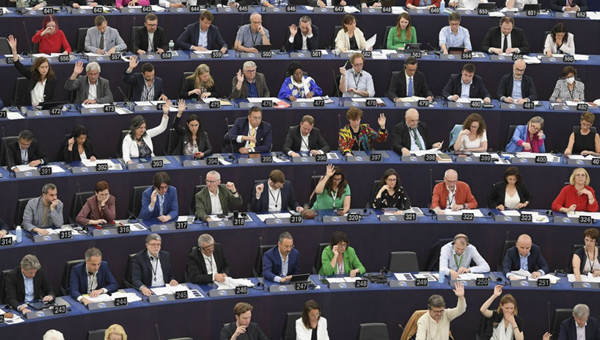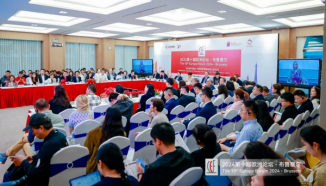The CCCEU Weekly Update 10 June 2022: Fine-tuning EU’s China approach?

EP Plenary session. 08/06/2022. Source: European Parliament
Fine-tuning EU’s China approach?
Editor’s Note: Welcome to the CCCEU Weekly Update. The chamber and PwC China have co-hosted a webinar on a heavyweight survey on the China-EU investment agreement. This week's Weekly Update focused on a fascinating fine tuning in the EU bubble: Brussels recently emphasised the need for engagement with Beijing ahead of the MC12 ministerial conference and the next EU-China high-level economic and trade dialogue.
What a busy and surprising week! Many people in Strasbourg may have experienced burnout before unexpected voting results came as either a shock or a relief.
The European Parliament appears to be engulfed in drama: a slew of key legislative measures from Brussels' iconic "fit for 55" package have hit a wall. It began with the European Parliament's rejection of Emissions Trading System (ETS) reform, and one after another, the EU Carbon Border Adjustment Mechanism (CBAM) and the Social Climate Fund legislation were left in limbo. According to reports, when the ETS reform voting results were displayed on the screen, there were both cheers and catcalls.
Given the increasing interest they have received on Chinese social media, your editor is likewise surprised by how closely Chinese media and experts have followed the development of the CBAM and ETS reforms.
Different fates awaited other "fit for 55" green legislative proposals. MEPs, for example, voted on Wednesday in favour of a proposal to prohibit the sale of new fuel cars in the EU beginning in 2035, including hybrid vehicles. The German Automobile Industry Association (VDA) promptly objected, stating that Europe lacked the necessary charging infrastructure to keep the ban in place, and that parliamentary action would raise consumer costs and jeopardise customer confidence.
China’s solar industry was nervous when MEPs presented its non-binding recommendations to ban products made with forced labour. "A new trade instrument to ban products made by forced labour," written by the EP’s International Trade Committee Chair Bernd Lange, was adopted.
The non-binding resolution, on the other hand, aims to be a "shout-out" to the European Commission, which is working on legislation to ban forced labour products. The commission is seeking evidence before presenting a legislative proposal in September 2022, in preparation for the state of the EU speech, which is slated for September. The collection period is from May 23 to June 20.
There is a critical window of opportunity to bring the matter to the attention of Chinese firms and specialists before European Commission President von der Leyen delivers her address.
On Thursday, the European Parliament passed a resolution on "the human rights situation in Xinjiang", criticising the human rights situation in Xinjiang and alleging that China’s relevant measures amount to crimes against humanity and represent a serious risk of genocide. "We strongly deplore and firmly oppose it," said the spokesperson of the Chinese Mission to the EU.
From a different perspective, various nuances in the EU's China-related agenda this week have emerged, including the following.
The importance of "strong" engagement with China was emphasised by the EU's senior ranks. Last Friday, the EU-27 trade ministers met and examined the EU-China trade relationship.
In the end, ministers noted "the importance of strong engagement with China". In his press conference, EC Vice-President and Trade Commissioner Dombrovskis said the EU’s engagement with China remains essential.
The EU's approach towards China is three-pronged: first, engagement or cooperation, as evidenced by the China-EU investment agreement; second, strengthening the EU's unilateral instruments, as evidenced by the FDI screening mechanism and foreign subsidy legislation; and third, working with allies, as evidenced by the TTC.
Following the war in Ukraine, China's label as the EU's "systemic rival" has been heightened, and Brussels now appears to be emphasising the "engagement" component, a move may seek to nurture a cooperative environment for the high-level bilateral economic and trade dialogue.
Second, trade ministers from China and Europe will meet. The 12th WTO Ministerial Conference (MC12) will be held in Geneva, Switzerland, from June 12 to 15.
According to China's Ministry of Commerce, WTO members are discussing intellectual property rights exemptions for the COVID-19 vaccine, pandemic response, fisheries subsidies, agriculture, and food security.
According to an exclusive story in the South China Morning Post, WTO Director-General Ngozi Okonjo-Iweala is pushing for progress on fisheries subsidies and vaccines, and China's position is critical. When it comes to China-Lithuania economic and trade relations, she believes members should try to resolve problems at the bilateral level; she also believes that China should not be targeted with special efforts.
According to the EU agenda, Dombrovskis is anticipated to hold bilateral talks with his Chinese counterpart during the conference. In addition, following the MC12 meeting, EU trade ministers will meet in Brussels on June 16 to discuss "China in the Multilateral System," among other topics.
Third, there appears to be a lot of wrangling going on concerning the Xinjiang resolution. According to media reports, the European People's Party (EPP) attempted to persuade the European Parliament to describe the situation in Xinjiang as "genocide" earlier this week, and urgent discussions were held between the party groupings to "align" the text's phrasing. However, it is reported that the Greens, the Left Party, and the ID do not support it in the European Parliament.
This should be considered alongside the European Parliament's resolution opposing forced labour customs measures, which has no legislative effect, and the European Commission's proposed legislative ban on forced labour products, which does.
Earlier, China has proved its commitment to honouring its promises and interacting with the outside world by ratifying two key ILO conventions and inviting UN High Commissioner for Human Rights Michelle Bachelet to visit Xinjiang.
Our take on recent China-EU dynamics is as follows:
-The EU's recent approach towards China has realistic considerations, and the China-EU high-level dialogue mechanism has a leading role in managing differences and promoting cooperation
-Risk factors and new developments in the EU should be monitored. CBAM, the ban on forced labour products, and the IPI have all had a significant impact on China-EU economic relations.
-The window for advocacy should be taken advantage of as soon as possible. When it comes to advocacy, it's always better to start early.
EU budget 2023 is out
The Commission has proposed an annual EU budget of €185.6 billion for 2023, to be complemented by an estimated €113.9 billion in grants under NextGenerationEU. The EU budget will continue to mobilise significant investments to boost Europe's strategic autonomy, the ongoing economic recovery, safeguard sustainability and create jobs. The Commission will continue to prioritise green and digital investments while addressing pressing needs arising from recent and current crises.
July rate hike plans
According to CNBC, The European Central Bank on Thursday confirmed its intention to hike interest rates at the policy meeting next month and downgraded its growth forecasts.
Following the latest monetary policy meeting, the Governing Council announced it intends to raise key interest rates by 25 basis points at the July meeting.
The ECB expects a further hike at the September meeting, but said the scale of that increment would depend on the evolving trajectory of the medium-term inflation outlook.
China's trade with EU up 7% in the first 5 months
According to customs statistics, the EU was China's second largest trading partner in the first five months of this year. The total value of China-EU trade reached 2.2 trillion yuan, up 7 percent, accounting for 13.7 percent.
Among them, China's exports to the EU 1.45 trillion yuan, an increase of 17.4%.
China's imports from the EU totaled 756.58 billion yuan, down 8.5%;
China's trade surplus with the EU reached 690.81 billion yuan, an increase of 70.2%.
What are experts talking about?
The assessment “EU-China cooperation on ‘green’ and ’social’ values” was published on the CEPS website by Weinian Hu and Jacques Pelkmans. The EU has long been concerned about sustainable development in China, i.e. the ‘green’ pillar (environment & climate) and in the ‘social’ pillar (core labour standards and social protection). Based on three research questions in both pillars, the authors have examined indicators and policies as well as degrees of convergence over time (with appreciable time lags). The process of convergence in the green pillar seems to go further than that of the social pillar, although recent developments stimulated by the CAI draft investment treaty have resulted in China ratifying two more core ILO conventions. This CEPS Policy Insight then ends with a short reflection on the prospects of sustainable development cooperation with China.
"To Stop China's Semiconductor Rise, the U.S. Is Doing These Three Things" was published in China-U.S. Focus. The article argues that the U.S. has "escalated" its all-around tactics in the semiconductor industry against China, using the "three axes" of establishing industry alliances to lobby, pushing legislation, and diplomatically "pulling the herd" against China ".At the same time, this article also analyzed and pointed out that the recent "three axes" of the United States, seemingly aggressive, but far from ironclad.
Please note: the English version of this issue is slightly different from our Chinese one. The views and opinions expressed in this article do not necessarily reflect the official position of the CCCEU.

 Login
Login Login
Login CCCEU and Gunnercooke Successfully Host Webinar on CSDDD and FLR Compliance to Guide Chinese Businesses
CCCEU and Gunnercooke Successfully Host Webinar on CSDDD and FLR Compliance to Guide Chinese Businesses Cultivating responsible China-EU business leaders essential to tackling global challenges
Cultivating responsible China-EU business leaders essential to tackling global challenges



